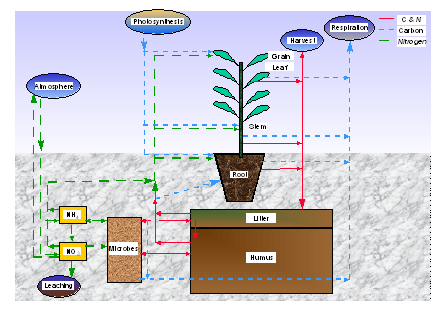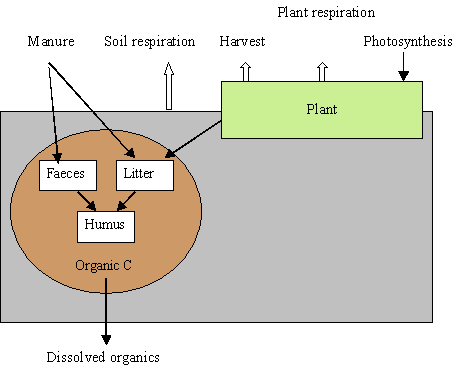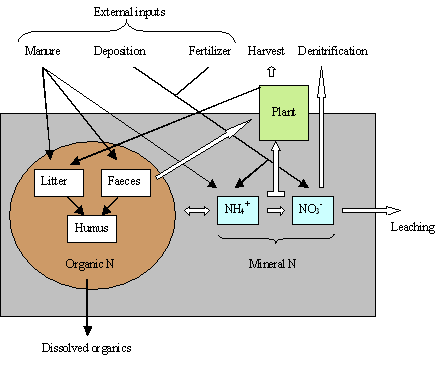Components of Nitrogen and Carbon

Figure 0.2. Schematic scheme of carbon, nitrogen and biomass flows (in one dimension) and storage. The soil is divided into layers and plant biomass can be divided into pools of annual and perennial tissues (Eckersten et al., 1998).
In the CoupModel the major nitrogen and carbon components of a soil-plant system can be considered (see Figure 0.2). This is accomplished by switching the Nitrogen and Carbon switch from off to any of the other two alternatives. Nitrogen and carbon processes may be simulated; either with the water and heat conditions as driving forces or with a dynamic interaction between abiotic and biotic components, though the latter approach is more common. In any case plant growth is simulated as carbon and nitrogen is taken up or given away from the plant i.e. the biomass in the plant is explicitly expressed.
Figure 0.3. Carbon flows in the CoupModel.
Carbon and nitrogen enters the soil either as external inputs, i.e. manure, deposition and fertilisation, or from the plant as litter fall (see Figure 0.3 and Figure 0.4). The carbon and the organic nitrogen are added to two organic pools in the soil called faeces and litter, whereas the mineral nitrogen goes into the ammonium or nitrate mineral pools.
When the organic matter starts to decompose, some of the carbon and nitrogen is transferred to the third organic pool, the humus pool, and some carbon leaves the soil as soil respiration. The decomposition of carbon by microbes affects the carbon nitrogen ratio in the organic soil. These changes are the driving force for immobilisation / mineralisation of nitrogen to or from the soil ammonium pool. Nitrogen is further transferred to the soil nitrate pool by nitrification.
Figure 0.4. Nitrogen fluxes in the CoupModel
Plants extracts nitrogen from the soil and carbon dioxide from the atmosphere during growth. Parts of this carbon dioxide is returned to the atmosphere during respiration. The plant may be harvested at the end of the growing season. This action together with denitrification processes and the leaching of nitrogen and carbon (decomposed organic matter and mineral nitrogen) removes carbon and nitrogen from the system.

